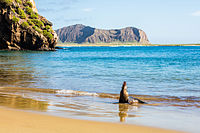
Photo from wikipedia
Marine oil slicks show brighter or darker than surrounding oil-free seawater under different sunglint, which can be observed by satellite optical sensors. Although this has been interpreted using a critical… Click to show full abstract
Marine oil slicks show brighter or darker than surrounding oil-free seawater under different sunglint, which can be observed by satellite optical sensors. Although this has been interpreted using a critical angle concept and simulated using the Cox-Munk model, it has not been demonstrated in high spatial resolution images from airborne sensors. In this study, an AISA (airborne imaging spectrometer for applications) image was used to determine the characteristics of non-emulsion oil slicks under sunglint in high spatial resolution images. Although a similar positive or negative contrast between non-emulsion oil slicks and oil-free seawater can be observed, it is difficult to directly model sunglint reflectance due to the different remote sensing scale effect. There are many sun glitter pepper noise produced by various micro-mirror facets of ocean surface in high spatial resolution images. Based on the optical image characteristics, a normalized noise index (ξ) was designed to evaluate the pepper noise in 1830 band-difference results. Then a level segmentation method was used to delineate the oil slicks under various sunglint from a minimum pepper noise image. Our study provides a preliminary reference for airborne optical remote sensing of oil slicks under various levels of sunglint.
Journal Title: Optics express
Year Published: 2018
Link to full text (if available)
Share on Social Media: Sign Up to like & get
recommendations!